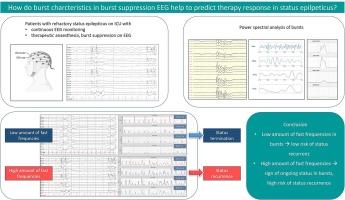Spectral properties of bursts in therapeutic burst suppression predict successful treatment of refractory status epilepticus
IF 4.6
Q2 MATERIALS SCIENCE, BIOMATERIALS
引用次数: 0
Abstract
Burst suppression (BS) on EEG induced by intravenous anesthesia (IVAT) is standard therapy for refractory status epilepticus (RSE). If BS has any independent therapeutic effect on RSE is disputed. We aimed to define EEG characteristics of BS predicting termination or recurrence of status after weaning. All RSE patients treated with IVAT while undergoing continuous EEG monitoring on the neurological intensive care unit between 2014 and 2019 were screened for inclusion. A one hour-period of visually preselected BS-EEG was analyzed. Bursts were segmented by a special thresholding technique and underwent power spectral analysis. Out of 48 enrolled patients, 25 (52.1 %) did not develop seizure recurrence (group Non SE) after weaning from IVAT; in 23 patients (47.9 %), SE reestablished (group SE). In group Non SE, bursts contained higher amounts of EEG delta power (91.59 % vs 80.53 %, p < 0.0001), while faster frequencies were more pronounced in bursts in group SE (theta: 11.38 % vs 5.41 %, p = 0.0008; alpha: 4.89 % vs 1.82 %, p < 0.0001; beta: 3.23 % vs 1.21 %, p = 0.0002). Spectral profiles of individual bursts closely resembled preceding seizure patterns in group SE but not in group Non SE. Accordingly, persistence of spectral composition of initial ictal patterns in bursts, suggests ongoing SE, merely interrupted but not altered by BS. Fast oscillations in bursts indicate a high risk of status recurrence after weaning from IVAT. EEG guided individualized sedation regimes might therefore be superior to standardized anesthesia protocols.

治疗性爆发抑制中爆发的频谱特性预示着难治性癫痫状态的成功治疗
静脉麻醉(IVAT)诱导的脑电图爆发抑制(BS)是治疗难治性癫痫状态(RSE)的标准疗法。BS 是否对 RSE 有独立的治疗效果尚存争议。我们旨在确定 BS 的脑电图特征,以预测断奶后状态的终止或复发。我们筛选了2014年至2019年期间在神经重症监护室接受持续脑电图监测的所有接受IVAT治疗的RSE患者。对视觉预选的一小时BS-EEG进行分析。通过特殊的阈值技术对脉冲串进行分割,并进行功率谱分析。在 48 名入选患者中,有 25 人(52.1%)在从 IVAT 断奶后没有癫痫复发(非 SE 组);有 23 人(47.9%)癫痫复发(SE 组)。在非 SE 组中,脉冲串含有更高的脑电图δ功率(91.59 % vs 80.53 %,p < 0.0001),而在 SE 组中,更快的频率在脉冲串中更为明显(θ:11.38 % vs 5.41 %,p = 0.0008;α:4.89 % vs 1.82 %,p = 0.0001):4.89 % vs 1.82 %,p = 0.0001;β:3.23 % vs 1.21 %,p = 0.0001:3.23 % vs 1.21 %,p = 0.0002)。在 SE 组中,单个爆发的频谱轮廓与之前的发作模式非常相似,但在非 SE 组中则不然。因此,阵发中初始发作模式的频谱组成持续存在,表明 SE 仍在持续,只是被 BS 中断而没有改变。阵发性快速振荡表明,从 IVAT 断奶后状态复发的风险很高。因此,以脑电图为指导的个体化镇静方案可能优于标准化麻醉方案。
本文章由计算机程序翻译,如有差异,请以英文原文为准。
求助全文
约1分钟内获得全文
求助全文

 求助内容:
求助内容: 应助结果提醒方式:
应助结果提醒方式:


